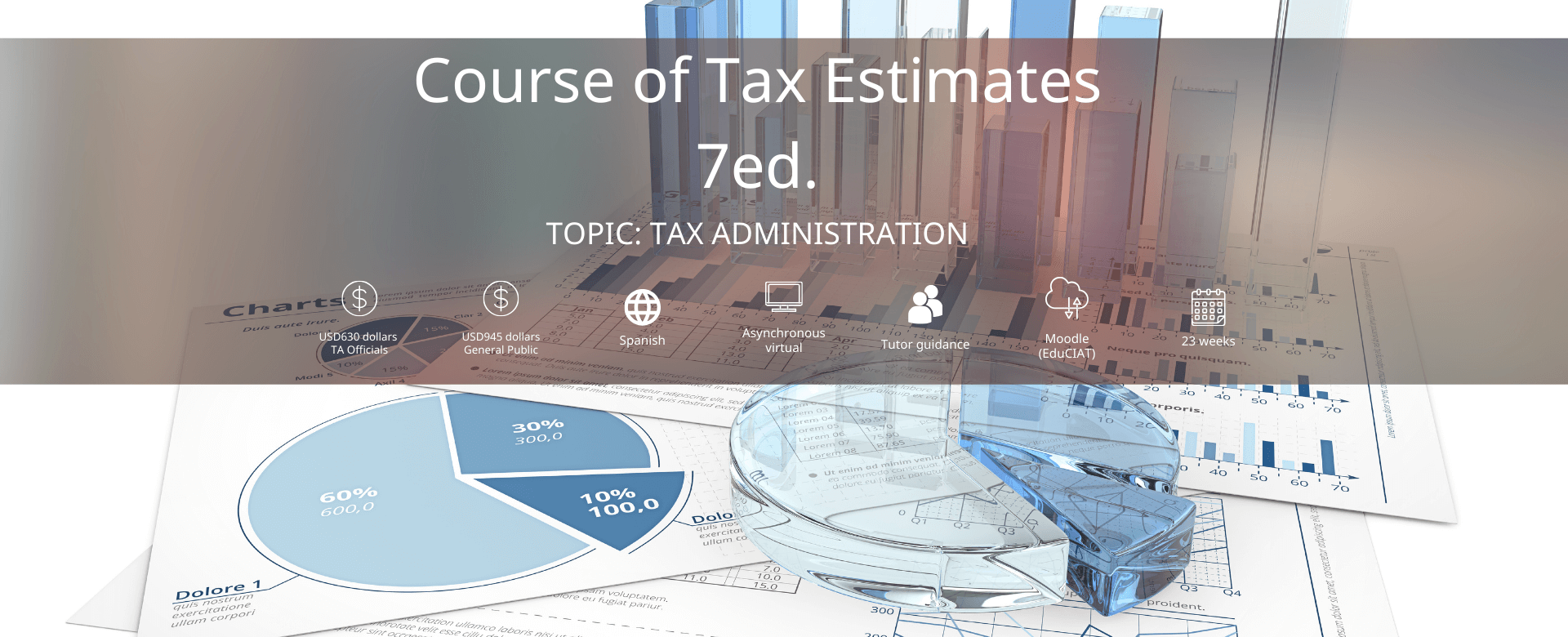
General Information
About the course
This course seeks to present a general view of conceptual aspects related to tax revenue and tax expenditures, provide the necessary techniques to carry out the tax revenue projections tasks (Time series analyses) and to prove the necessary knowledge for the works of Tax Expenditures quantification. The following topics will be developed during the course:
Module I
– Lesson 1. Determinant factors in tax collection
– Lesson 2. Tax collection system.
– Lesson 3.1 Methods for projecting tax collection
– Lesson 3.2 Direct method for projecting tax collection
– Lesson 4. Methods for analyzing the variations of tax revenues
– Lesson 5. The economy of tax revenues
Module II
– Lesson 1. Econometric methods for the forecast. Temporary series and their components
– Lesson 2. Deterministic self-projecting forecast methods
– Lesson 4. BOX-JENKINS Methodology. Automatic forecast
– Lesson 5. Seasonal and general ARIMA models. Identification, estimation, diagnosis and forecast
– Lesson 6. Seasonal and general ARIMA models. Automatic forecast
– Lesson 7. Analysis of intervention and transfer function models
Module III
– Lesson 1. Conceptual Framework
– Lesson 2. The reference framework and identification of items that result in the tax expense
– Lesson 3. Tax expense estimation methods
Target audience
Officers and individuals involved in tax administrations of CIAT member countries and with responsibilities in the design and implementation of public policies.
Certification
The Training Coordination issues academic certificates of approval in digital format, which requires that participants have obtained the minimum passing grade of the course.
When
May 06 to October 13, 2024.
Registration Deadline
April 19, 2024
Offer - Prepaid
Make payment by April 05, 2024 to get a discount:
- TA Officials: USD 504.00 (Regular Price USD 630.00)
- General Public: USD 756.00 (Regular Price USD 945.00)
Request it at mdonoso@ciat.org
Frequently Asked Questions
What are the technical requirements for the CIAT courses?
The participants will need the following tools:
- Internet connection.
- Updated browser (Google Chrome, Mozilla Firefox or Safari).
- Permissions to receive external e-mails.
- Adobe Reader.
- Java.
- Zoom, the tool for synchronous sessions.
How many hours should I dedicate to the course?
For the individual activities, you should dedicate at least one hour a day to review and complete the material. In the case of collaborative work, it varies from one to two hours for the correct development of the work that you have to do, together with your classmates. Generally, we calculate a weekly dedication of 12 to 15 hours. In general, the activities have a closing date on Sundays at 23:55 hours in Panama.
What is a virtual classroom?
The virtual classroom is the space where you will find the study materials, homework, discussion forums, exams and complementary material; in addition, you communicate with the tutor and classmates takes through the option of messages and communication forums. Through these means, you have the possibility to ask questions, resolve your concerns and academic doubts. The tutor will be present throughout your learning and teaching process.
In case of problems, who should I contact?
In order to better assist you and answer your questions, please contact the following:
- For computer assistance: César Trejos (ctrejos@ciat.org) and Maureen Perez (mperez@ciat.org)
- For administrative assistance: Mónica Donoso (mdonoso@ciat.org) and Maureen Perez (mperez@ciat.org)
- For academic assistance: Your tutor (through the platform).
The virtual classroom is equipped with several communication tools to share ideas and information.
What are the steps to withdraw from the course?
Within the first 10 days students must write a message to the Tutor with copy to the Administration with their intention to postpone it; demonstrating that it is due to justified situations of force majeure. The withdrawn student will be entitled to the amount of the payment made and may use it to enroll in the next edition of the training program. He or she will start again from the first lesson.

Alejandro Juarez
ajuarez@ciat.org
Maureen Pérez Álvarez
mperez@ciat.org
César Trejos Canto
ctrejos@ciat.org
Mónica Donoso
mdonoso@ciat.org
More about CIAT
-
Celebration of the 30th anniversary of the Tax Law Department at the Externado University of Colombia
-
CIAT participated in the 18th Plenary Meeting of the Global Forum on Transparency and Exchange of Information for Tax Purposes (GF).
-
CIAT participated in the opening panel of the launch of Brazil’s CONFIA Program
-
CIAT participated in the annual meeting of the VITARA program to define strategic actions for 2026
-
Registration is now open for courses to 2026!
-
CIAT participated in the 11th Methodological Meeting with Large Taxpayers of the AGT dedicated to Electronic Invoicing
-
Vapes: Emerging Challenges for Tax Administrations in Latin America
-
Mutirão, BAM and CBAM: Environmental taxation and unification of reports
-
AI is already here
-
CIAT and AECID co-sponsored a seminar on innovation and international collaboration to combat tax evasion
